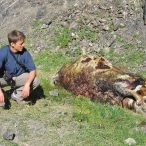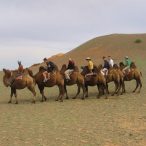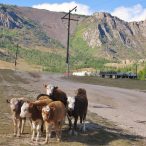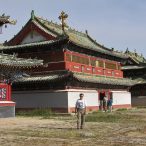Mongolia
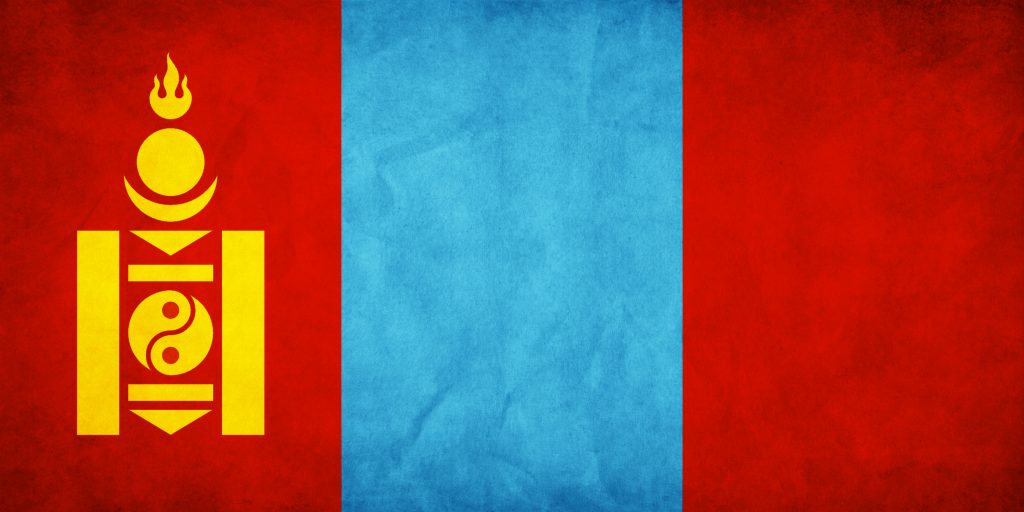
Official name: Mongolian People’s Republic
Population: 3 100 000
Area: 1 564 116 km²

Gallery
The Mongol Empire was founded by Genghis Khan in 1206 and I went to Mongolia in 2006 – on the country`s 800th anniversary!
Tourist attractions of Mongolia, the unique weather of Mongolia, Mongolia – the present times, history of Mongolia.
Tourist attractions of Mongolia
Most people I’ve met know very little about Mongolia, and if they do this information is incorrect. I always wanted to visit the homeland of Genghis Khan to also have this experience, but at first glance I can see that this country`s days of glory are gone.
Mongolia lies in East Asia, “squeezed” between Russia and China. Some data indicate that this is Central Asia, but I do not agree with it. I divide Mongolia into Inner and Outer Mongolia. The Outer Mongolia is outlined in the country’s borders and the Inner Mongolia is a part of northern China. Mongolia is five times larger than Poland and the population is just over 2.5 million. It`s been calculated that there is approximately 1.5 km2 of land for every person. For comparison, in England they is only 3-4m2 per person. This of course guarantees means a lot of space for wild adventures.
Despite the extremely inhospitable and difficult living conditions offered by Mongolia and the horror stories about all the dangers waiting for me, tourism is improving year by year. Within the scheduled time I`m going to explore this vast country in its true way, without any improvements or luxuries. To me personally the greatest asset of this country is the absolute silence and the “endless plains”. Simple and quiet life, observation of nature and bactrians and goats grazing on the background of sand dunes guarantee an unforgettable experience. Mongolia is full of beautiful national parks and animals living in them, although I advice to not expect any comfort. Ulan Bator has several interesting museums which show the cultural life of Mongolia. Apart from that not many temples survived, and even those are not in the best condition.
I would therefore recommend Mongolia only to those who enjoy an extremely close contact with nature, and to those who easily adapt to local conditions. In the north of the country there are vast lakes, reindeers and excellent fishing conditions, and in the south there is vast Gobi desert, which offers unforgettable attractions. In addition to sleeping on the empty and flat as a pancake steppe, you can ride horses and camels, you can climb sand dunes and have plenty of time for lone thinking. But usually people travel in groups, what means that each participant is able to get to know their own and other people`s weaknesses. When I came back to Ulan Bator after 11 days in the Gobi Desert, I had to recover for a few days but it was worth it. Unfortunately Mongolia is stll a very unpopular country, despite the fact that it offers mutton dumplings, mear`s fermented milk and sleeping in a tent in total wilderness, with strong winds and -25oC. I`m sure that roads would be also good if they existed, what makes you overcome the naked steppe and sometimes even throw big stones in to the rivers, so our 40 year old Soviet car could go through. All of that is of course accompanied with beautiful views, absolute quiet, grazing animals, sand dunes and a beautiful canyon. It’s hard to believe that someone would prefer to go to the Greek islands.

Buddhist temples in Mongolia.
The unique weather of Mongolia
In terms of climate Mongolia is very inhospitable as temperatures range here from 400C to -40oC, with winters and summers taking even 5 months. Ulan Bator is the coldest capital of the world because as early as in October temperature falls below zero and goes down to -30oC, and similar temperature remains until April. In the the vast, boundless steppes wind makes it even colder, and the great distance from the sea makes the climate very dry in the south and cool in the north. Generally, Mongolia fries during long summers and freezes during harsh winters. No wonder that only the toughest are able to survive in such conditions.
Mongolia – the present times
Economy:
When it comes to the economy of Mongolia, it still has the largest trading relationship with Russia and China, what does not develop its economic situation very well. This also translates into historic problem, that`s why Mongolia cooperates with many countries of Western Europe and the USA. Despite this, Mongolia is still poor and very dependent on the outside help, and it is also very infamous for its legendary corruption. Mongolia’s foreign debt is still about 760 million USD. The main branch of the Mongolian economy is still about breeding animals (sheep, goats, camels, horses, cows), what goes very well with the vast steppes covered with low vegetation, but it also represents traditions arising from the Mongolian culture, although this is not always profitable (16%). I want to recall that Mongolia is a very cold country and during winter 2009-2010 Mongols lost 9.7 million animals, what immediately affected the prices of meat. Agriculture in Mongolia is not popular because of stupid use of pesticides and heavy machinery during the communist period, what means that most of the land is not suitable for cultivation. The forestry management is even worse (only 10% of the country is forested).
Extractive industry plays quite a big importance in Mongolia, and mining (24,8% GDP) here includes: silver, gold, copper, tungsten, tin, zinc, bronze, and more. They could also extract oil but unfortunately they do not have appropriate machines. I suspect that in particular the mining industry will grow quickly in Mongolia because right now it counts for 80% of exports, and in the future it will be 90%. Fur industry used to be also important, but it decreased year by year. These were the skins of camels, sheep and wild animals such as wolves, but squirrel skins were also very popular.
I definitely classify Mongolia to developing countries, although it stand higher that for example Bangladesh or Nepal. Unfortunately still 22,4% of Mongols live below the poverty level, what means that they have to survive for $1,25 a day.
Education:
Education in Mongolia is on a much better level than in the hopeless Indian Subcontinent. The Government of Mongolia provides 11 years of free teaching, which will be extended to 12 years in 2019. Although for historical reasons Russian is better known, English is taught in schools from the fourth grade. Literacy stands at 97.4% what puts Mongolia as a leader of developing countries.
Health:
In the health sector Mongolia has made very good progress. Indicators such as life expectancy and the number of infant mortality have improved. There are also about 80 hospital beds per 10,000 people, and for example in Bangladesh there are only 4 per 10,000. There is no malaria in Mongolia but travellers have to be vaccinated against: polio, hepatitis A and B, typhoid and rabies because of the high risk of contact with animals.
HIV/AIDS in Mongolia is at a very low level but the number of infections is increasing. The reason is the lack of education about safe sex, poor condom use, and the fact that Mongols like to have mistresses. When I was in the Gobi Desert, the drivers went to the yurts in the desert to “visit” female friends. Unfortunately, they are not always armed in condoms.

In a bar with Mongols in the Gobi desert.
Culture/Religion:
About half of the Mongolian population lives in the capital of Ulan Bator and the rest leads nomadic way of life, unchanged for centuries. These people inhabit steppes having only emptiness consisting of flat surface, horizon and lack of trees. Just as a few hundred years ago they still live in their yurts / gers – tents with wooden frames covered with goat and sheep fur. People living in the Gobi desert or other steppes are forced to move because bactrian (camels with two humps), sheep, horses and goats are able to quickly strip the land of greenery, and then people have to dismantle their gers and look for new pastures. From what I noticed yurts are also set up on the outskirts of Ulan Bator throughout the year, what probably solves housing crisis of this poor country.
A few words about Mongolian cuisine; and as you can guess based on the location of Mongolia, seafood is definitely not a national dish. There are however many varieties of mutton dumplings. The national dish is “hushur” or fried dumplings stuffed with mutton meat. The drink is more adventurous as it is fermented mare`s milk called “ajrak” – drunk hot or cold. Some people vomit straight after drinking “ajrak”, but I quite liked it. Ajrak is very necessary for people living in the plains because it is a valuable source of vitamins. Outside of the capital of fruit not seen. Unfortunately the same drink in Kyrgyzstan called “kymyz” is very hard to swallow.
The main religion in Mongolia is Tibetan Buddhism (97%), although there are also Christians and Muslims, and until today shamanism is practiced by about 1%. Mongols` favourite sport is Nadaam festival which consists of three disciplines: horse riding, archery and wrestling, and sometimes also falconry if it can be classified as sport. Naadam is one the greatest Mongolian traditions and has been organised for centuries. Mongolians also have their own traditional clothes called “deel”, which have been worn for centuries by women and men. It is a kind of rich patterned robe, with tied belt and a hat. To a tourist here is a lot of tough but a good time in Mongolia.
Media:
Freedom of press in Mongolia is classified as quite free, but I don`t believe it, because corruption is a specialty of Mongolian politics. In 2010 Mongolia in terms of press freedom was on 76th place, and two years later on 100th. In my opinion ther is certainly more press freedom in Mongolia than in Turkmenistan (veeeery interesting country!!!), but it is a kind of freedom that is losing and gaining strength, depending on what suits the government.
Environmental problems:
Mongolia has a big problem with air pollution in Ulaanbaatar and other urban areas, where there is heavy industry. There are also many contaminated surface and deep waters. In addition, excessive deforestation and grass stripped by animals leads to the desertification of the country. Considering the large area of ??Mongolia, majority is not suitable for cattle pastures or for cultivation, and this limitation is also due to natural barriers, as the Gobi Desert in the south-east and mountains in the north-west.
Mongolia has currently 14 endangered species of birds and 12 species of endangered mammals. This are species such as: Przewalski’s horse, bactrian, snow leopard and Tartar saiga.
History of Mongolia
The earliest data about Mongolia come from Chinese sources when the country was not yet known as the present Mongolia. It is known that Mongolians were warlike people who lived on the steppes and led nomadic lifestyles. They were so strong that in the fourth century BC they created a strong state in central Asia, but under pressure of Chinese troops they fell in the I century BC. Huns (as they were called) went even to fight in Europe and contributed to the fall of Rome. Over the next XI centuries Mongolia was ruled by other nations, but this domination ended in the early XII century, when Mongols freed themselves from the domination of China.
The breakthrough came in 1206 when certain Temujin (later Genghis Khan) was elected as the Khan of all Mongols, and in that year he founded Mongolia. Genghis Khan united the neighboring peoples who turned out to be such a great power that he conquered all of the northern China and Central Asia. To the capital of Karakorum at that time, were brought many reaches and Mongolia grew stronger. Successors of Genghis Khan conquered Russia, the rest of China, the Middle East, Tibet and even some areas of Eastern Europe. Then, at the turn of the thirteenth and fourteenth century the Mongol Empire was the largest power known to the mankind until today. No other empire was as extensive. To govern such a vast territory was very difficult because the empire was divided into three parts. For example, areas of China and Mongolia were in one part and the capital of Karakorum moved to Chanbalyk (today Beijing).
The dominance of the Mongols in China ended in 1368, when in a result of an anti Mongolian uprising the power was taken over by China’s Ming Dynasty. This was the beginning of the end of the great Mongol Empire, and after few years Chinese troops leveled Karakorum to the ground, the southern part of Mongolia became a part of China and the rest of the country separated into smaller states. Even when Manchurians conquered Inner Mongolia, who later became the rulers of the whole of China, Mongolia still remained under Chinese protectorate.

Bactrians in the Gobi Desert. Mongolia.
The whole of the twentieth century I personally call the “great geographical misfortune” for Mongolia. At this time, this small country, sandwiched between two big powers-Russia and China was in their possession at all times. Position of this very poor and very weak country meant that Mongolia gained something briefly when Russia and China fought each other for influence. For example, in the early twentieth century, China began to control and colonize Outer Mongolia. Then the Mongol princes turned to Russia for assistance, what resulted in revolution against the ruler of China in 1911. Then with the help of Russia Mongolia declared independence. Nevertheless, after Chinese-Russian negotiations in 1915, Mongolia became a part of China although it did agree to its autonomy. However, when the Russian Communist revolution broke out in 1919, China invaded Outer Mongolia, overthrew the government and re-occupied the country. But two years later, the Russian army, along with a few princes of the Mongol armies won the Urge (today Ulaanbaatar) and the rest of Outer Mongolia, which started the uprising against China.
Then the Red Army, under the pretext of aid to the revolutionaries of Sukhbaatar took power over Outer Mongolia and established a communist government. Soon after, it began to proclaim the establishment of the Mongolian People’s Republic. While Mongolia was formally independent it was still a part of China and was under strong influence of Russia. From 1920s of the twentieth century until the outbreak of World War II, it was the time of murdering of the Mongolian nobility, burning temples, national goods and taking their property. There was also a strong Russification of the country which is characterized for example by replacing Mongolian alphabet with Cyryllic. It paid off only in such a way that when in 1939 the Empire of Japan attacked Mongolia, Joint Soviet-Mongolian forces defeated Japan.
After the war, China and Russia imposed a treaty in which they were to finally settle the matter of Outer Mongolia. As a result of the referendum, China recognized the independence of the Mongolian People’s Republic, but few years later the government of Mao Zedong once again asked for Mongolia. Finally, after the Soviet-Chinese agreement in 1951 the Chinese government finally recognized the independence of this country in 1961, and it was admitted to the United Nations. It is worth mentioning that in spite of its independence, Mongolia was still a socialist country under strong Soviet influence. Another 30 years was a communist period but after the collapse of the Eastern bloc in Europe and especially after the collapse of the Soviet Union, Mongolia also had to adjust to the new circumstances. Turning point was in 1990 because of changes in the Communist Party, and finally democratization of the country started. Mongolia became a parliamentary republic and freedom of religion and private property were restored. The last Russian troops left Mongolia in 1992.
Travel reports
Map
Location
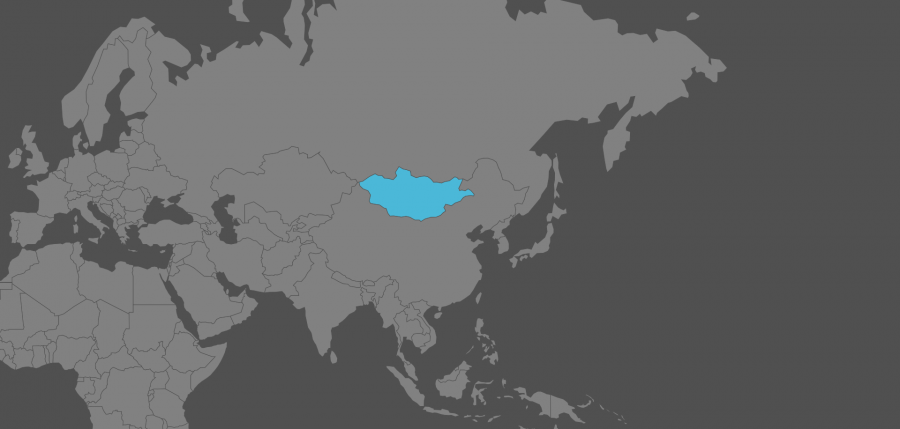
Practical information
Tourist Visa: There are many types, single, double and multiple and prices are calculated in proportion of the length. A single entry one month visa should cost about $40 – $50.
Safety: there are reports of thefts at railway stations and airports, and bag snatches on the streets of Ulan Bator. I always felt safe and never saw anything like it. There are also reports of attacks on trains, but I presume it is an occacional occurance. To me only Mongolian drivers are truly dangerous because they treat pedestrians as a moving target.
Moving around the country: Coaches must be forgotten by travellers because they are hopeless. They are few hours late or do not come at all. State of the roads across Mongolia is a macabre. In Ulan Bator, every car is a potential taxi. For further destinations I recommend trains but unfortunately they do not go everywhere. It is best to go to the north (Lake, reindeer, etc.) or south (Gobi Desert, sand dunes, etc.) in a group tour when driver and car are included. It is a great adventure!!!
Prices: (in 2006 when £1 = about 2200MNT)for bed in Ulan Bator I paid $5. For living in yurts in the Gobi desert about $2 – $3. Taxis in Ulan Bator are a question of few dollars. Food in the pub (mutton dumplings, salad, tea), I paid a few $ $ $. It is better to pay in local currency. For 8-day expedition to the Gobi desert in a group of 11 people I paid $111, and it was a great price and a great experience.
Climate: moderate continental. Mongolia in terms of climate is very inhospitable as temperatures range here from 40oC to -40oC, with winter and summer taking even 5 months. Ulan Bator is the coldest capital of the world, and as early as in October the temperature falls below zero and goes down to-30oC, and a similar temperature remains until April. The vast, boundless steppes and wind makes it even colder, and the great distance from the sea makes the climate very dry in the south and cool in the north.




